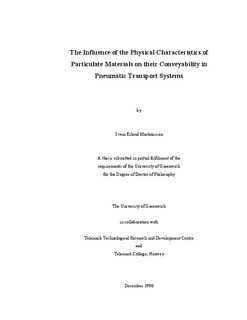| dc.contributor.author | Martinussen, Svein Erlend | |
| dc.date.accessioned | 2012-03-09T13:31:34Z | |
| dc.date.accessioned | 2017-04-19T12:52:12Z | |
| dc.date.available | 2012-03-09T13:31:34Z | |
| dc.date.available | 2017-04-19T12:52:12Z | |
| dc.date.issued | 1996-12 | |
| dc.identifier.citation | Martinussen, Svein Erlend. The Influence of the Physical Characteristics of Particulate Materials on their Conveyability in Pneumatic Transport Systems. Doctoral thesis, University of Greenwich, 1996 | |
| dc.identifier.uri | http://hdl.handle.net/11250/2438495 | |
| dc.description.abstract | The aim of the investigation has been to establish a link between the physical characteristics of particulate materials, measurable on small samples in a laboratory, and the conveyability of these materials in a pneumatic conveying line. The focus of the investigation has been on conveying velocity limits, and the problem has been approached by comparing own experimentally obtained values against existing models for the prediction of such limits. A quantitative analysis shows that the accuracy of these models range from 77% under prediction to 116% over prediction at certain operating conditions within the area in which they are claimed to be valid. The pressure data obtained in the experimental investigation have been subjected to various methods of analysis to identify typical behaviour of the pressure fluctuations along the pipeline when changes in the mode of flow, or blockage, is approached. The results of this analysis show that the change from stratified flow (or partially settled suspension flow) to unstable flow, often also referred to as the saltation limit, is associated with the occurrence of coherent structures moving along the pipeline. To investigate the possibility of applying a fluid dynamic model to understand these phenomena, experiments with wave propagation and damping have been carried out in a channel with fluidized powders. This investigation shows that the wave propagation velocity at large wave length to bed depth ratios for a fluidized powder is identical to that expected from theory on fluid dynamics. The fluid dynamic model is then applied to establish a model for the prediction of maximum obtainable feed rate of solids in a given pipeline. It is also used to establish a model to predict the limit of stable conveying, in suspended or partially suspended flow, based on the Kelvin Helmholz instability for stratified flow of liquids in closed pipelines. The models are purely mechanistic and require no empirical fitting. | no |
| dc.language.iso | eng | no |
| dc.publisher | Telemark University College | no |
| dc.subject | pneumatic transport | en |
| dc.title | The Influence of the Physical Characteristics of Particulate Materials on their Conveyability in Pneumatic Transport Systems | no |
| dc.type | Doctoral thesis | |
| dc.type | Peer reviewed | |
| dc.description.version | Published version | no |
| dc.subject.nsi | 553 | en |
